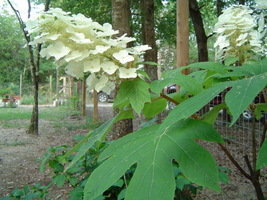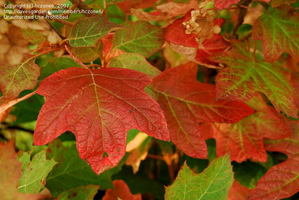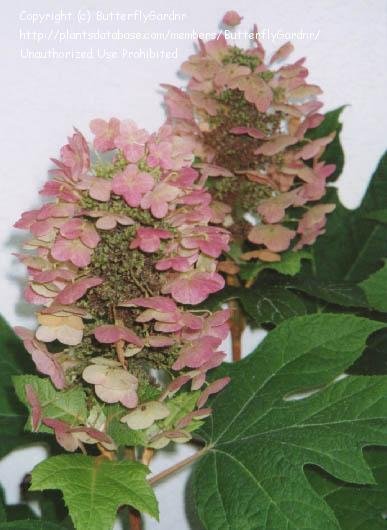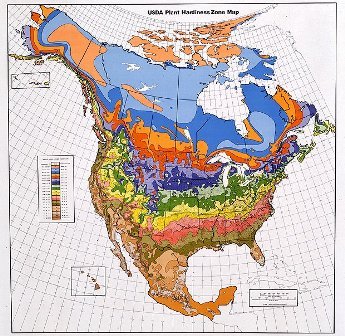





(Editor's Note: This article was originally published on June 18, 2008. Your comments are welcome, but please be aware that authors of previously published articles may not be able to promptly respond to new questions or comments.)
The deciduous shrub, oakleaf hydrangea, Hydrangea quercifolia, which is native to the southeastern United States, has long been one of my favorites. But upon moving to my husband's family farm in Missouri thirteen years ago, I discovered to my dismay that oakleaf hydrangeas did not thrive on the windy hillock we call home. And so each year I missed seeing their brilliant lantern-like panicles growing in the shady corners of my yard.  Still I attempted to grow them on several occasions. They all died brutal deaths in the icy winds which buffet our abode each winter. Nevertheless, I was determined...
Still I attempted to grow them on several occasions. They all died brutal deaths in the icy winds which buffet our abode each winter. Nevertheless, I was determined...
During our landscaping endeavors we created a microclimate on the southeast side of our yard by designing a garden wall made of privacy fence. It was there that I planted yet another oakleaf hydrangea. I hoped the oakleaf would be protected from old man winter's ravaging breath beneath the boughs of a tall bald cypress nearby.
Surprisingly enough our enthusiastic hydrangea survived the winter. I cannot express my consummate relief at seeing those verdant green leaves sprout the following spring. But time would prove there were no blooms upon my hydrangea. The leaves were large and vivacious with life, but it would not bloom. Alas I discovered one day whilst gazing upon my long dreamt of hydrangea that the flower buds had been damaged by Missouri's mulishly cold winter. There was hope, for my oakleaf had been large when I planted it. And I knew in climates akin to northwest Missouri's where the winter temperatures regularly fall below -10 F if your oakleaf successfully reaches a large size then it is more likely to thrive. Even if one does not bloom annually there is pleasure to be derived by simply admiring its multifarious foliage each season.
Here are a few suggestions for growing the oakleaf hydrangea in northwest Missouri or similar zones. Locate a semi-shady site along the southeast or east side of your home. Considering the fact that oakleafs prefer well-drained soul amend your soil if desired. I did not amend mine. Instead I planted in a slightly raised bed for enhanced drainage. Once your oakleaf is happily planted mulch it to help retain moisture at its base. You may fertilize your hydrangea if you like. Mine has not yet required fertilizer.
 In the fall as you enjoy the vibrant hues of your oakleaf hydrangea add a thick layer of mulch for winter protection. Check your oakleaf periodically throughout the cold season and apply additional mulch if you feel it is necessary. In the spring you should notice the first sign of grayish-green leaves as the hydrangea wakes from its winter rest. Do not fret if there are no leaves in March, even April. Oakleaf hydrangeas like to wait until the weather is truly warm before they show you their beauty.
In the fall as you enjoy the vibrant hues of your oakleaf hydrangea add a thick layer of mulch for winter protection. Check your oakleaf periodically throughout the cold season and apply additional mulch if you feel it is necessary. In the spring you should notice the first sign of grayish-green leaves as the hydrangea wakes from its winter rest. Do not fret if there are no leaves in March, even April. Oakleaf hydrangeas like to wait until the weather is truly warm before they show you their beauty.
If your oakleaf hydrangea survives the coming winters to reach a mature size, it is much more likely to continue to survive and bloom as well. My oakleaf hydrangea, I am thankful to say, has grown into a happy and well-adjusted shrub upon the windy hillock we call home.
 ~Good gardening~
~Good gardening~
Oakleaf Hydrangea Facts
It is a broad, rounded deciduous shrub of unique beauty up to 6' tall. I have seen them taller. The leaves are similar to the leaves of the Red Oak tree. The bark is attractive. White panicles open to 12" clusters of creamy flowers in early to late summer in the Midwest, sooner in the south. The flowers slowly age to blushing pink then by fall a delicate brown. The aged flowers make nice dried arrangements.The leaf color ranges from orange to red and even burgundy in Autumn. Oakleaf Hydrangeas prefer rich, well drained soil. But they will wilt readily when thirsty.Oakleaf Hydrangeas perform best in shady areas. Oakleaf Hydrangeas spread by stoloniferous roots, (sucker roots). But it is not invasive.Propagate Oakleaf Hydrangea by seed, woodcuttings or root ball division.USDA Hardiness Zones of Oakleaf Hydrangea

Oakleaf Hydrangea is hardy in zones 6a-9b
'Snow Queen' is a variety which is hardy to zone 5 and can be grown in the sun.
Note: oakleaf hydrangeas look particularly well under planted with shade loving perennials. Try the spotted deadnettle, Lamium 'Beacon Silver' with its pretty pink flowers or perhaps lily-of-the-valley. The possibilities are endless. You determine the ultimate beautiful end.
As always each garden is filled with variables. Trial and error is the best method in determining that which you can achieve.
The Florida oakleaf hydrangea photo is courtesy of my mother. The thumbnail is my oakleaf hydrangea, growing in Missouri. All others are from the gracious members at Dave's Garden. These photos and more information about oakleaf hydrangeas, as well as many other plants, are available within the PlantFiles collection at Dave's Garden. Thank you all for the helpful information and photographs you have provided at the PlantFiles.
Warning: Portions of the oakleaf hydrangea are poisonous if ingested. Young children and pets should be monitored when in its vicinity.
Copyright © www.100flowers.win Botanic Garden All Rights Reserved